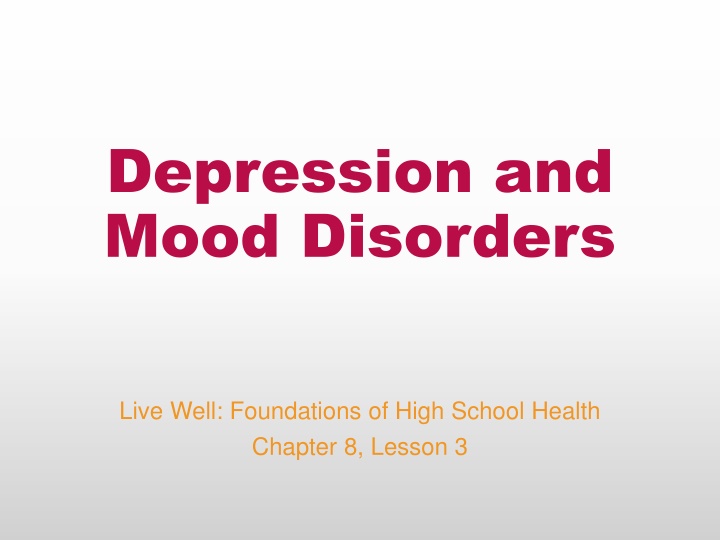
Understanding Depression and Mood Disorders: Causes, Types, and Impacts
Learn about mood disorders, including depression, their causes, common types, and impacts on daily life and relationships. Explore risk factors, characteristics, and the distinction between sadness and depression. Discover signs of depression and how it can affect overall health and well-being.
Download Presentation

Please find below an Image/Link to download the presentation.
The content on the website is provided AS IS for your information and personal use only. It may not be sold, licensed, or shared on other websites without obtaining consent from the author. If you encounter any issues during the download, it is possible that the publisher has removed the file from their server.
You are allowed to download the files provided on this website for personal or commercial use, subject to the condition that they are used lawfully. All files are the property of their respective owners.
The content on the website is provided AS IS for your information and personal use only. It may not be sold, licensed, or shared on other websites without obtaining consent from the author.
E N D
Presentation Transcript
Depression and Mood Disorders Live Well: Foundations of High School Health Chapter 8, Lesson 3
Write About It When was the last time you felt really sad? How long did your sadness last, and what impacts did it have on your daily activities and relationships?
Can you . . . Explain what mood disorders are and describe their characteristics of using three examples? Describe risk factors associated with mood disorders? Compare and contrast sadness and depression? Identify five signs of depression?
What Are Mood Disorders? Mood disorders are disorders that affect a person s emotional state. They include disorders in which a person experiences long periods of extreme happiness, extreme sadness, or both.
Common Types of Depression and Mood Disorders Persistent depressive disorder Postpartum depression Psychotic depression Seasonal affective disorder Bipolar disorder Disruptive mood dysregulation disorder
Causes of Mood Disorders Factors that might contribute to the development of mood disorders include imbalances in brain chemicals, life events and psychosocial factors, and genetics and family history.
Understanding Depression Major, or clinical, depression is a common but serious mood disorder. Anyone can become depressed, but females are slightly more likely than males to become depressed. Risk factors for teen depression include personal or family history of depression, major life changes, trauma or stress, and certain physical illnesses and medications.
Depression and Health Conditions When people are dealing with a major depression, they often struggle to take care of their health. Depression can also happen because a person is dealing with a serious medical illness, such as diabetes or cancer.
Sadness Versus Depression Sadness is different from depression. Sadness is a normal human emotion that we feel as a result of a situation or event. When someone is depressed, they can t engage in normal daily activities, and they feel hopeless and often don t see a way out.
Managing and Treating Depression Depression and other mood disorders are complex mental illnesses that require professional guidance and help. Common approaches to treatment include the following: Antidepressant and mood stabilizing medicine Psychotherapy Family therapy or counseling Brain stimulation therapies
Self-Care and Depression Self-care strategies for depression include the following: Stay physically active and get regular exercise. Set realistic goals for yourself. Spend time with other people you trust. Avoid isolating yourself; reach out to others. Respect that improving your condition will take time. Continue to learn about depression as a condition.
Skill-Building Challenge Use a decision tree to map the choices you have when you are dealing with a situation that makes you sad. Think of a situation you are in or have been in and use that situation for your tree. Once you have completed your tree, decide which choice had the best outcome and explain your decision.
